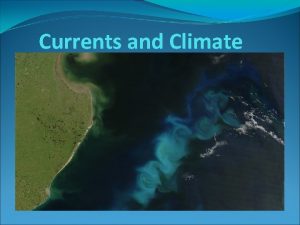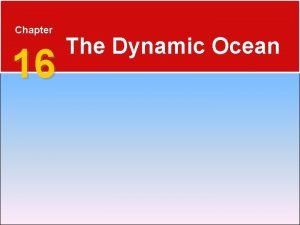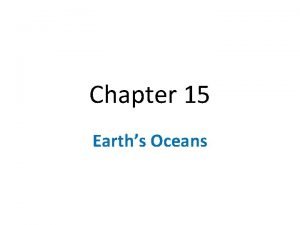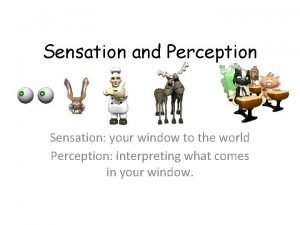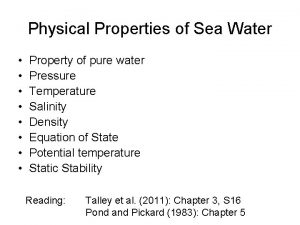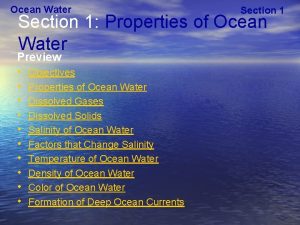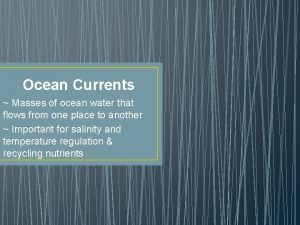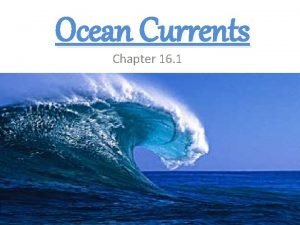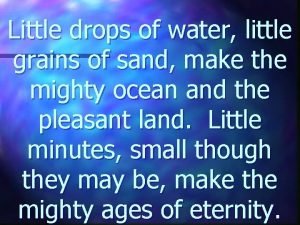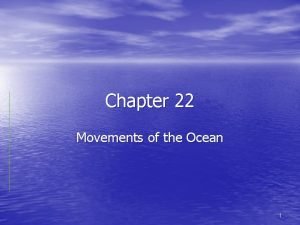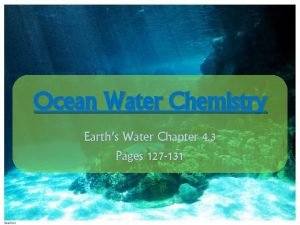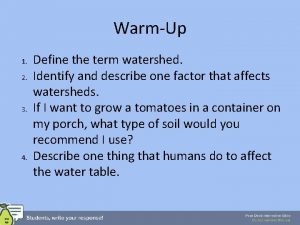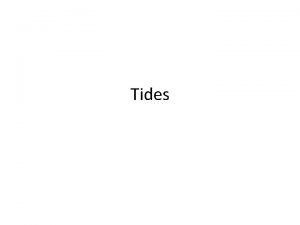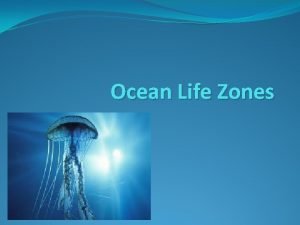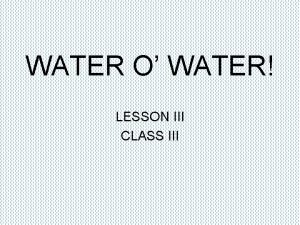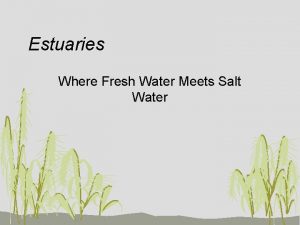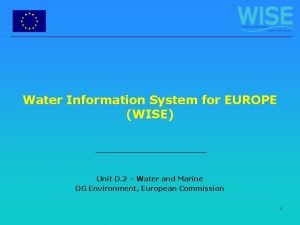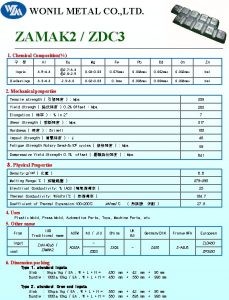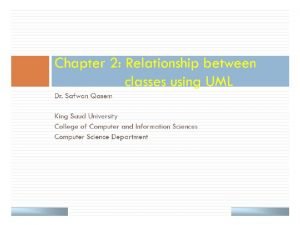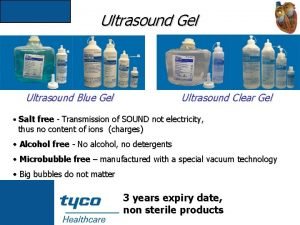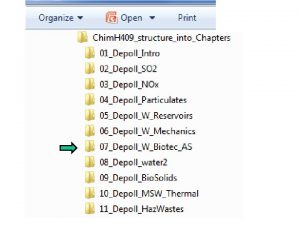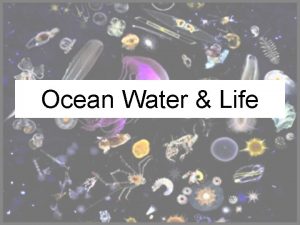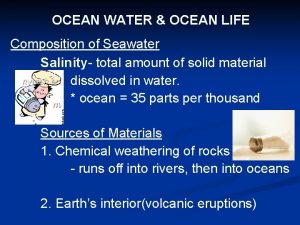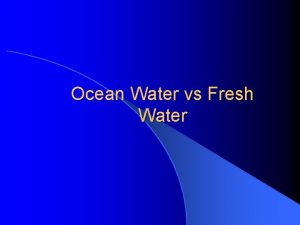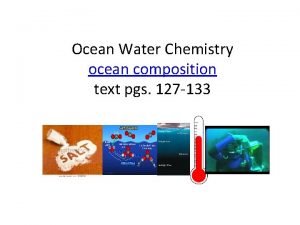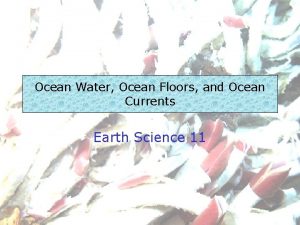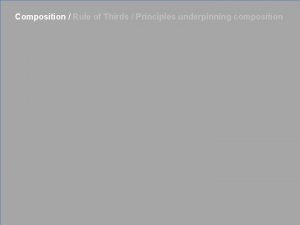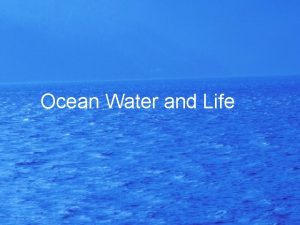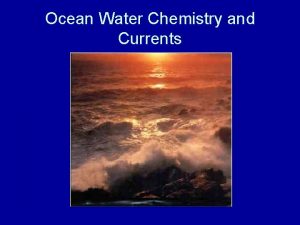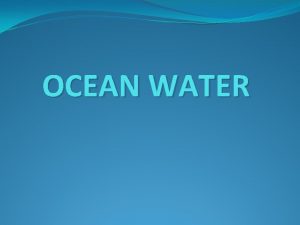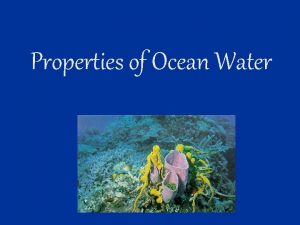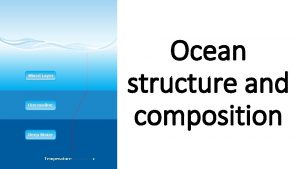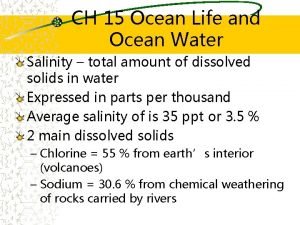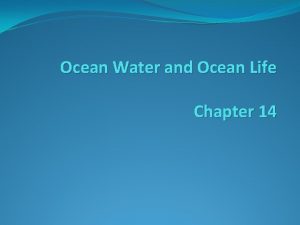Ocean Water Life Ocean Water Life Composition of












































- Slides: 44

Ocean Water & Life

Ocean Water & Life • • Composition of Seawater Ocean Temperature & Density Variation Diversity of Ocean Life Oceanic Biological Productivity

PSCI 131: Ocean Water & Life Composition of Seawater

PSCI 131: Ocean Water & Life Composition of Average Seawater

PSCI 131: Ocean Water & Life Composition of Normal Seawater • Salt sources Minerals from the continents Undersea volcanism

PSCI 131: Ocean Water & Life Processes Affecting Salinity • Total mass of salt in open oceans doesn’t change, but salinity does • Salinity is mass of salt / mass of water • So, water must be added/removed for salinity to change

PSCI 131: Ocean Water & Life Processes Affecting Salinity • Salinity increases if water is removed – Evaporation – Sea ice formation

PSCI 131: Ocean Water & Life Processes Affecting Salinity • Salinity decreases if water is added – Precipitation – Runoff (rivers) – Sea ice melting – Icebergs melting

PSCI 131: Ocean Water & Life Global Salinity Variation • Salinity varies by latitude

Ocean Acidity • Rising CO 2 in atmosphere impact chemistry of ocean – About 1/3 of human-generated CO 2 ends up dissolved in ocean – p. H drops, seawater becomes more acidic • Impacts on ocean life: – Microbes and corals have trouble building hard parts from Ca. CO 3 because acidic water dissolves Ca. CO 3

PSCI 131: Ocean Water & Life Ocean Temperature and Density Variations

Temperature and Density • Influence deep-ocean circulation and distribution and types of life • Both vary with depth

Temperature • Surface water temp varies with amount of solar radiation • Low latitudes – High temperature at surface – Rapid decrease in temperature with depth (thermocline) • High latitudes – Cooler surface temperatures – No rapid change in temperature with depth

PSCI 131: Ocean Water & Life Temperature vs Depth Warm latitudes Cold latitudes

PSCI 131: Ocean Water & Life Thermocline • Rapid decrease in water temperature with increasing depth • Exists year-round in tropics/subtropics • Never appears in subpolar/polar latitudes • Seasonal in temperate latitudes

PSCI 131: Ocean Water & Life Ocean Water Density • Density is mass per unit volume – How heavy something is for its size • Determines water’s vertical position in ocean • Controlled by temperature and salinity – Higher temp = lower density – Higher salinity = higher density

Variation by latitude • Low-latitudes – Low density at the surface – Density increases rapidly with depth (pycnocline) because of colder water • High-latitudes • High-density (cold) water at the surface • Little change in density with depth

PSCI 131: Ocean Water & Life Density vs Depth Warm latitudes Cold latitudes

PSCI 131: Ocean Water & Life Pycnocline • Rapid increase in water density with increasing depth • Mirror image of thermocline – Temperature has stronger influence on density than salinity

PSCI 131: Ocean Water & Life Ocean Water Layering • In regions where a thermocline is present – Surface mixed zone: warm, well-circulated – Transition zone: location of thermocline – Deep zone: cold, dark

PSCI 131: Ocean Water & Life Ocean Water Layering • If no thermocline, then no layering – Polar, subpolar, temperate (in winter)

Diversity of Ocean Life

Ocean Life • Home to 228, 000 and growing organisms – Bacteria, algae, squid, fish, sharks, whales, etc. • Most life in sunlit surface waters where photosynthesis takes place

Plankton • Floaters – drift with the ocean currents • 2 groups: • Phytoplankton – plants • Zooplankton - animals

Nekton • Swimmers – move independently of ocean currents

Benthos • Bottom dwellers – live on or in ocean bottom

Marine Life Zones • Distribution of marine organisms depends on: – Availability of sunlight – Distance from shore – Water depth

Sunlight Availability • Photic (light) zone – Upper part of ocean – Sunlit – Euphotic zone is near the surface where the light is strong • Aphotic (without light) zone – Deep ocean – No sunlight

Distance from shore • Distance from shore – Intertidal zone—area where land ocean meet and overlap – Neritic zone—seaward from the low tide line, the continental shelf out to the shelf break – Oceanic zone—beyond the continental shelf

Water depth • Pelagic zone—open ocean of any depth • Benthic zone—includes any sea-bottom surface • Abyssal zone—a subdivision of the benthic zone – – – Deep Extremely high water pressure Low temperatures No sunlight Sparse life Food sources include decaying particles from above, large fragments falling, and hydrothermal vents


PSCI 131: Ocean Water & Life Oceanic Productivity

PSCI 131: Ocean Water & Life Controls on Marine Productivity • Primary productivity: rate at which organisms store energy through formation of organic matter using energy derived from • Photosynthesis (solar radiation) • Chemosynthesis (chemical reactions) • What determines how much biomass a given place at a given time can support? • Availability of sunlight • Amount of nutrients in the water

PSCI 131: Ocean Water & Life Controls on Sunlight Availability • Sunlight availability in the ocean depends on sun angle • Sun angle controlled by Relationship of latitude to sun angle. • Latitude • Season Relationship of season to sun angle.

PSCI 131: Ocean Water & Life Nutrients: What are they? • Nutrients are elements and compounds dissolved in ocean water (sodium, phosphorous, carbonate, etc. ) • Needed by phytoplankton to live • Phytoplankton live in surface waters • These waters become depleted in nutrients as phytoplankton use them up

PSCI 131: Ocean Water & Life Nutrients: How are they replenished? • Upwelling: movement of deeper, colder, nutrient-rich water up to surface • If upwelling is limited or prevented, surface waters will have low biomass

PSCI 131: Ocean Water & Life Role of the Thermocline • Thermocline restricts vertical water movement • Regions with strong thermocline have nutrient-poor surface water Warm latitudes Cold latitudes

PSCI 131: Ocean Water & Life Role of Phytoplankton in Productivity • Phytoplankton are the foundation of the marine food web • If phytoplankton biomass changes, total biomass changes Diatom and zooplankton biomass in the Barents Sea over 12 months. Diatoms are a type of phytoplankton.

PSCI 131: Ocean Water & Life Annual Marine Productivity by Latitude

PSCI 131: Ocean Water & Life Marine Productivity: Polar/Subpolar • Low productivity except for mid-summer • Surface waters are nutrient-rich • Isothermal (no thermocline) year-round • But, sunlight is scarce for most of the year • In mid-summer, enough sunlight becomes available to cause spike in phytoplankton biomass

PSCI 131: Ocean Water & Life Marine Productivity: Tropical/subtropical • Low productivity year-round • Sunlight is plentiful year-round • But, strong thermocline exists year-round • Surface waters are well-lit, but nutrient-poor

PSCI 131: Ocean Water & Life Marine Productivity: Temperate latitudes • Productivity varies by season • Sunlight availability and presence of thermocline change significantly • Winter – low productivity • Spring – limited productivity • Summer – Strong thermocline, no replenishment from below • Fall – Thermocline breaks down, nutrients return to surface

PSCI 131: Ocean Water & Life Marine Productivity: Temperate latitudes Productivity in the temperate-latitude surface ocean over 12 months.

PSCI 131: Ocean Water & Life End of Chapter
 Chapter 15 ocean water and ocean life
Chapter 15 ocean water and ocean life Water and water and water water
Water and water and water water Types of divergent plate boundary
Types of divergent plate boundary Ocean ocean convergent boundary
Ocean ocean convergent boundary Ocean to ocean convergent boundary
Ocean to ocean convergent boundary Ocean ocean convergent boundary
Ocean ocean convergent boundary Convergent plate boundary
Convergent plate boundary Convergent oceanic oceanic plate boundary
Convergent oceanic oceanic plate boundary Red and blue ocean strategy
Red and blue ocean strategy Percent composition by mass
Percent composition by mass Empirical formula from percent composition
Empirical formula from percent composition The periodic daily rise and fall of ocean water
The periodic daily rise and fall of ocean water Large whirl of water within an ocean basin
Large whirl of water within an ocean basin Mass of ocean water that flows from one place to another
Mass of ocean water that flows from one place to another Which percentage of earth’s oceans is dissolved salts?
Which percentage of earth’s oceans is dissolved salts? The human ability to speedily recognize familiar objects
The human ability to speedily recognize familiar objects Salinity unit of measurement
Salinity unit of measurement Ocean water properties
Ocean water properties Masses of ocean water that flow from one place to another
Masses of ocean water that flow from one place to another Masses of ocean water that flow from one place to another
Masses of ocean water that flow from one place to another Grains sand drops
Grains sand drops Streamlike movements of water in the ocean called
Streamlike movements of water in the ocean called Ocean water chemistry
Ocean water chemistry Salinity
Salinity The periodic daily rise and fall of ocean water
The periodic daily rise and fall of ocean water Make an ocean life zones foldable
Make an ocean life zones foldable Water consumption water meter reading worksheet
Water consumption water meter reading worksheet Dock water allowance
Dock water allowance Water o water
Water o water 5 divided by 1/4
5 divided by 1/4 A paved blacktop parking lot was built
A paved blacktop parking lot was built Water to water heat exchanger
Water to water heat exchanger Fresh water meets salt water
Fresh water meets salt water Warm water rises in a lake. cold water descends.
Warm water rises in a lake. cold water descends. Water water everywhere project
Water water everywhere project Sources of water sources of water
Sources of water sources of water Unit 11 water water everywhere
Unit 11 water water everywhere Zamak 5 chemical composition
Zamak 5 chemical composition Percent composition bubble gum lab answer key
Percent composition bubble gum lab answer key Unity composition
Unity composition Class diagram static class
Class diagram static class Diagramme de classe définition
Diagramme de classe définition Uml private public
Uml private public Kemipur 100
Kemipur 100 Typical composition of untreated domestic wastewater
Typical composition of untreated domestic wastewater












